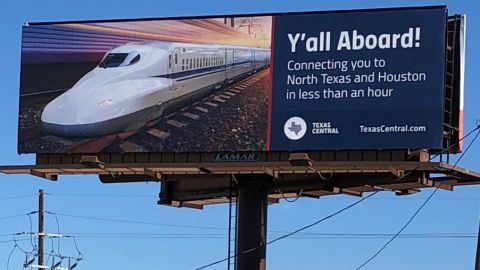
The companies hired to build a high speed passenger train between Dallas and Houston announce signing a $16 billion dollar agreement with developer Texas Central.
The news release from Lane Construction and its parent company, Webuild Partners, does not state when construction begins.
The reaction from the president of Texans Against High Speed Rail states that Texas Central does not have the money and has not filed the required full construction application with federal regulators.
Texas Central as of Tuesday afternoon issued no statement on its website or its Facebook page.
News release from Lane Construction and Webuild Partners:
The Lane Construction Corporation and its parent company and joint-venture partner Webuild Group have signed a final agreement worth $16 billion with Texas Central that marks the latest milestone ahead of the start of construction of a high-speed railway between Dallas and Houston. The ambitious project promises fast, safe, and environmentally friendly travel as well as thousands of jobs and a major boost to the economy. It is one of the single biggest infrastructure investments of its kind in the United States by value and will be the first true high-speed rail service in the country, having it join the ranks of countries that have high-speed rail service, including Japan, China, France, and Italy.
This agreement consolidates the results of the planning and advanced design stages of the project, as well as actualizing its value.
“We are excited to be part of this historical project that will bring high-speed rail to the United States,” said Mark Schiller, President and CEO of The Lane Construction Corporation. “It’s a true milestone for our country’s sustainable transportation infrastructure, and we are enthusiastic to bring 130 years of experience and expertise to the table as the contractor of choice to build it.”
“We are truly honored to have been chosen by Texas Central, that relies on our worldwide expertise to bring sustainable mobility to the country with the first true ‘end-to-end’ high-speed railway,” said Pietro Salini, CEO of the Webuild Group. “Being part of such a challenging project as leader of the design and construction of the railway is a unique experience that we are extremely proud of. This is a wonderful opportunity to further focus our presence in the U.S., our biggest single market, together with Lane, the company building first class transport infrastructure for the country for the past 130 years”.
According to the final contract, Lane and Webuild will execute all the heavy construction for the project, designing and building all 236 miles of the alignment, the entire track system, nearly half of it on viaduct, and the buildings and services for maintenance and other equipment, including industrial buildings, train depots, and facilities. Much of the alignment is elevated and will benefit from Lane’s expertise in constructing bridges and viaducts to reduce impacts as much as possible on landowners and residents of the counties the project will traverse.
The Dallas-Houston high-speed railway will transform mobility between the two cities. Based on Central Japan Railway’s Tokaido Shinkansen system, it will carry travelers at speeds of up to 200 miles per hour, bringing them to either destination in less than 90 minutes, with a single stop at Brazos Valley near Texas A&M University. Departures will be every 30 minutes during peak hours and every hour during off-peak hours. This technology will reliably transport more than 400,000 passengers every day and help reduce greenhouse gas emissions by an estimated 101,000 tons per year – emissions that would otherwise be produced by car and air travel between the two cities. By 2050, approximately 13 million people are forecast to use the train.
The train offers a safer alternative to today’s commuter options. Millions of passengers safely and securely ride high-speed trains every day across Europe and Asia. They have proved to be the safest and most reliable mass transportation option in the world today. Japan’s Shinkansen High-Speed Train System has a 50+ year history in Japan of no crashes, fatalities, or injuries due to train accidents. In 2016 alone, there were 3,773 fatalities on Texas roads, many of which occurred on the stretch of I-45 between North Texas and Houston, which consistently ranks as one of the most dangerous in the United States.
The project is expected to provide the economic impact of 84 Super Bowls totaling about $36 billion over the next 25 years and create 17,000 direct jobs during the six years of construction and more than 1,500 permanent jobs when the train service becomes fully operational. An estimated $7.3 billion worth of materials from U.S. suppliers across 37 states are planned to be used.
Lane and Webuild bring to the project over a century of experience in building large, complex civil engineering projects throughout the world. Its track record stands at more than 8,500 miles of rail and metro lines, which includes in the United States the Central Subway tunnel in San Francisco, California and the LYNX Blue Line Extension in Charlotte, North Carolina.
Webuild is also working on projects to improve the connection of rail networks across Europe, such as the Brenner Base Tunnel under the Alps, which will be the longest railway tunnel in the world at 41 miles; the Terzo Valico dei Giovi high-speed/high-capacity railway between Genoa and Milan, which will have the longest railway tunnel in Italy.
Statement from Texans Against High Speed Rail president and Waller County judge Trey Duhon:
“Texas Central takes every opportunity to generate what sounds like progress to keep interest and investments alive. But Webuild is just a new name for Salini Impregilo, which has been working with Texas Central for a while now. Additionally, Texas Central doesn’t have $16B or the permits needed to construct. Almost a year after being denied an expedited permit, Texas Central has yet to even file the required full construction application with the Surface Transportation Board in DC. Texas Central has been reporting that construction will begin “within the next six months,” “later this year,” or “soon” for the last five years. With no money or permits, we do not see any progress here, just something to get their name in the news in an attempt to remain relevant.”
